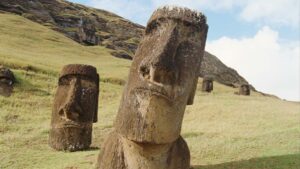“Ancient Secret Unearthed: Discover the Enigmatic 2,200-Year-Old Pyramid Concealed in Middle Eastern Mountains!”
Imagine traipsing through the arid expanse of the Middle Eastern desert and stumbling upon a 2,200-year-old pyramid! Yep, you read that right. Archaeologists have unearthed this intriguing four-sided structure in the Judean Desert, straddling the West Bank and Israel, a region steeped in religious significance for billions. This peculiar discovery—not your typical Egyptian pyramid—comes as a delightful surprise, leading to countless questions begging for answers. What on earth was its purpose? A guard tower? A grand monument? Or maybe a fancy grave marker for the ancient elite? Join the adventure as we delve into this historical mystery! LEARN MORE
Archaeologists studying a rural Middle Eastern desert have discovered a rather mysterious and unusual pyramid that dates back a whopping 2,200 years.
Located in the Judean Desert, it is a huge plot of land across the West Bank and Israel that sits east of Israel and stretches all the way to the Dead Sea.
A critically important region of the planet for those who follow Judaism, Islam, and Christianity, the desert itself has been the location of a new historical find in the form of the four-sided structure.
Unearthed by scientists examining the area, it dates back to the Hellenistic period which is roughly 300 BC to 30 BC and is made up of individual stones weighing hundreds of kilograms each.
Leading the excavation has been the Israel Antiquities Authority (IAA) and Israel’s Ministry of Heritage, with the archaeological find labelled as a ‘historical mystery’. It’s not exactly what we’re used to seeing pyramid wise when it comes to Ancient Egypt, for example.

Excavating the site (Judean Desert Survey Unit / Israel Antiquities Authority)
Already an incredibly rich site, a number of items have been recovered in the region such as Greek scrolls, bronze coins, weapons, and even wooden cutlery, it is the latest in a very exciting trend for experts and volunteers working across the desert at points of interest as efforts are upped to stop looting and selling historical goods on the black market.
Matan Toledano, Dr. Eitan Klein, and Amir Ganor from the IAA have been leading on the project. In a statement on the pyramid, they said: “This pyramidal structure is huge and made of hand-hewn stones, each one weighing hundreds of kilograms.
“In the first excavation week, the volunteers found written historical documents, exceptional bronze vessels and remains of ancient furniture, which thanks to the desert climate were preserved in amazing condition.
“Every moment new findings are discovered, and we are filled with anticipation for what else the next three weeks might reveal.”

The terrain of the Judean Desert is not kind to people, with hundreds of caves lining its cliffs (Getty Stock Images)
What the pyramid stood to do, and the purpose behind its build, is not known as of yet.
The team behind the excavation say: “Is this a guard tower, guarding an important commercial route through which the Dead Sea resources of salt and bitumen were transported to the coastal ports?
“Or at some point was this enormous structure on the mountaintop marking a grave, or serving as a monument in ancient history?
“It is a historical mystery. And to our delight, the public coming to volunteer in the excavation are our partners in uncovering the answers.”

On top of the pyramid (Israel Antiquities Authority)
Further excavation of the site is ongoing as we speak, with the event beginning on 17 March and ending on 4 April.
“There are exceptional and world-important finds left at the site, still waiting to be discovered,” the IAA says on its website as it invites volunteers to become part of the dig.
“You too are invited to join us and take part in uncovering history.”
With more than 900 caves documented by the IAA along the cliffs of the Judean Desert, it is the latest in a very long period of studying humanity from a very different time.














